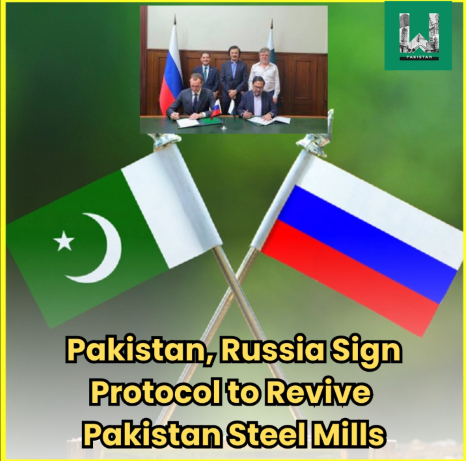Pakistan: Steel Dreams and Shadows of Corruption

By Nasir Aijaz
The AsiaN Representative
ISLAMABAD: [On July 11, 2025, Pakistan and Russia signed an agreement to restore and modernize Pakistan Steel Mills (PSM), located in Karachi, the capital of Sindh province. The agreement was signed at the Pakistan Embassy in Moscow by Secretary Ministry of Industries and Production Saif Anjum and General Director of Industrial Engineering LLC from the Russian side Vadim Velichko, in the presence of Special Assistant to Prime Minister Haroon Akhtar Khan and Pakistan’s Ambassador to the Russian Federation Muhammad Khalid Jamali, stated a press release.
In May this year, Islamabad and Moscow had agreed to establish a new state-of-the-art steel mill in Karachi. Built with Soviet assistance in the 1970s, PSM has been a financial burden on the state, lying dormant since June 2015.
The government has decided to dismantle the existing facility, allocating 700 acres to the Sindh government for a new state-of-the-art steel mill, while additional land will be used for an industrial park.]
The story of Pakistan Steel Mills (PSM) is a narrative deeply intertwined with the aspirations, failures, and recurring challenges faced by Pakistan’s industrial sector. Established in the 1970s under the leadership of Prime Minister Zulfiqar Ali Bhutto, with assistance from Russia, PSM embodied a vision of national self-sufficiency and industrial prowess. Sprawling over 700 acres in Karachi, it was heralded as a symbol of modernization and a testament to Pakistan’s ambitions to emerge as an industrial power. Yet, despite its grand inception and lofty goals, the steel mill’s journey is one riddled with mismanagement, pervasive corruption, and ultimately, systemic failure.
In its prime, PSM represented hope—hope that Pakistan could forge its own steel industry, reduce dependence on imports, and stimulate economic growth.
However, the enterprise was marred almost from the outset by a series of managerial inefficiencies, political interference, and nepotism that gradually eroded its potential.
Over the decades, corruption scandals, delay-driven procurement processes, and the siphoning off of funds under the guise of bureaucratic and political favoritism tarnished its reputation.
The facility’s infrastructure, which once symbolized progress, eventually became a burden, prone to misallocation of resources and neglect. Instead of evolving into a sustainable backbone of the nation’s industry, it turned into a symbol of bureaucratic inertia and wastage.
By 2015, the financial losses had become insurmountable, prompting the government to shut down PSM. The rationale was straightforward: the sprawling industrial complex, once a source of national pride, was now a symbol of failure, inefficient management, and corruption.
The decision to dismantle was driven primarily by the recognition that the old infrastructure, laden with corruption and neglect, could no longer serve any productive purpose. The land, vast and valuable, was left vacant amid financial burdens and political indecision. Successive governments, instead of attempting reforms, opted for a binary choice—either to throw good money after bad or to completely write off the project.
Yet, history’s lesson is clear: industrial failures rooted in corruption and mismanagement rarely remain isolated incidents. Instead, they often serve as cautionary tales for future endeavors.
The recent move by Pakistan’s government to revisit the steel industry symbolizes this complex paradox. An agreement with Russia aims to revive PSM, not merely restoring it to its previous state but transforming it into a modern, technologically advanced facility. The promise is compelling; land has been allocated for a new plant, and plans are underway to establish a state-of-the-art steel mill that ostensibly addresses past flaws and incorporates modern management practices.
However, skepticism is both warranted and persistent. The saga of Pakistan’s industrial sector offers ample reasons for caution. The history of PSM is emblematic of a pattern where grand projects, initiated with nationalistic fervor and regional cooperation, often become entangled in corruption, mismanagement, and vested interests.
Rebuilding the steel industry after decades of neglect and systemic decay isn’t solely an engineering or technological challenge; it demands transparent governance, strict accountability, and the political will to combat entrenched corruption. Without these safeguards, the possibility of the project devolving into a repeat of past failures or white elephants remains high.
The renewed partnership with Russia, while symbolizing strategic and regional cooperation, also needs to be critically examined. It is easy to romanticize the potential as a milestone in bilateral ties, but the real challenge lies in implementing reforms that prevent history from repeating itself.
Past attempts at modernization often faltered because of weak governance structures, lack of transparency, and the influence of vested interests that manipulate state resources for personal gains. Without a decisive break from these patterns, even the most advanced technology and generous foreign partnerships risk being co-opted or misused.
Beyond technical and financial considerations, the revival of PSM underscores a broader issue: the necessity of confronting corruption head-on. The narrative of Pakistan Steel Mills serves as an enduring reminder that ambitious projects, no matter how well-intentioned or technologically sound, can become white elephants if oversight, transparency, and accountability are not prioritized.
As the government moves forward with plans to rebuild and modernize the steel industry, it must do so with the recognition that sustainable industrial growth depends on good governance—something the country has historically struggled to uphold.
In conclusion, the fate of Pakistan Steel Mills encapsulates a complex tale of ambitions thwarted by mismanagement and corruption but also offers a glimmer of hope through renewed interest and cooperation. Whether this renewed effort will succeed or merely replicate past failures remains uncertain.
If Pakistan genuinely intends to transform its industrial future, it must address the systemic issues that have plagued projects like PSM for decades. Only then can the promise of modern, competitive, and corruption-free industry become a reality, turning a chapter of failure into a blueprint for sustainable growth.




